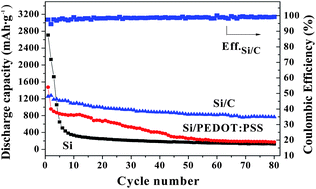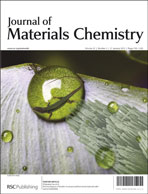Nano-silicon composites, Si/poly(3,4-ethylenedioxythiophene):poly(styrenesulfonate) (PEDOT:PSS) and Si/C, were prepared by an in situ chemical polymerization of 3,4-ethylenedioxythiophene (EDOT) with nano-Si particles in a PSS aqueous solution and subsequent carbonization of Si/PEDOT:PSS, respectively. The nano-Si particles were embedded in a shapeless PEDOT:PSS matrix and amorphous carbon in the corresponding composite. Energy dispersive spectroscopy (EDS) and X-ray photoelectron spectroscopy (XPS) measurements revealed that 2.66 wt% of the element sulfur was doped in the carbon matrix for Si/C composite. Both the Si/PEDOT:PSS and Si/C composite electrodes exhibited higher initial coulombic efficiency and better cycling performance than the bare nano-Si anode. The Si/C composite showed the best electrochemical performance, retaining a specific capacity of 768 mA h g−1 and a Coloumbic efficiency of 99.2% after 80 cycles, with a very small initial capacity loss of 2.80% and a capacity fade of 0.48% per cycle.

You have access to this article
 Please wait while we load your content...
Something went wrong. Try again?
Please wait while we load your content...
Something went wrong. Try again?


 Please wait while we load your content...
Please wait while we load your content...